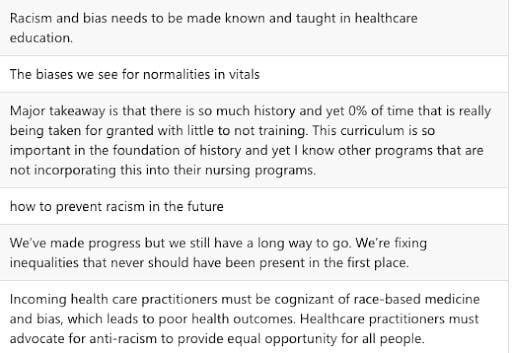Faculty Spotlight: Ashley Graham-Perel on the Colloquium of Nursing History and Anti-Racism Affirmation

Ashley Graham-Perel, Interim Director of Cultural Affairs and Assistant Professor of Nursing in the Masters Direct Entry (MDE) nursing program at CUIMC, was the recipient of a 2022-23 Provost Teaching and Learning Grant in Innovative Course Module Design. Dr. Graham-Perel worked with the Center for Teaching and Learning, and Teaching Assistants Lauren DeVaughn and Hodaya Lightstone, to develop the “Colloquium for Nursing History and Anti-Racist Affirmation,” a two-part lecture series that was embedded in the Fall 2022 N5800 Nursing Topics course required of all 225 MDE students. Through the colloquium, nursing faculty and students examine racism in the history of the nursing profession, reflect on how it informs their nursing practice, and explore measurable vestiges of racism in current healthcare practice.
Why did you design this new course? What challenge did you face?
People are often overwhelmed when trying to understand and resolve racism and inequities in healthcare because they isolate the problems to the present. Only through understanding the past and nursing history, can we better define the problems of inequities in healthcare and develop solutions as practitioners. In the professional growth and development of future nurses, one must understand where the profession comes from and the professional legacy you are inheriting.
As educators, it is essential to understand the magnitude of the problem of health inequity, that being, it is a chronological problem that is at the core of our discipline and in our roots. To move forward, we must acknowledge nursing history, understand the background of our health inequality and racism, and not be overwhelmed by it. As an academician and nurse historian, I encourage my students to ask: “Where do we fit into this history and how do we shape the future?” The “Colloquium in Nursing History and Anti-Racism Affirmation” is an introduction to finding the answer to that question.
What is the intervention that you implemented and how does it enhance the student learning experience?
The “Colloquium for Nursing History and Anti-Racist Affirmation” is a two-part lecture series. The series promotes active learning through discussion of nursing history and employs students with the skills to further explore history while addressing current racial inequities in healthcare. The strategy uses micro learning and asynchronous video vignettes to initiate incorporation of nursing history into nursing curriculum. With digitized nursing history, students are exposed to historical nursing content that customarily requires archival research and experience in historical research. The production and digitization of the historical content provides accessibility of content for future use. In addition, the colloquium series serves as a faculty guide for facilitating historical content and discourse in nursing curriculum. The key interventions included the two didactic lectures on nursing history and the socially responsible nurse, reflection assignments, and two supplemental video vignettes on measurable instances of racism.
What are the goals and objectives for your course?
The key learning outcomes are as follows:
- Understand the dynamic history of nursing ideas and practices, their implications for patients and health care providers, and the need for lifelong learning. More specifically students will recognize how the history of nursing has contributed to anti-black racism and inequities in healthcare today.
- Develop chronological thinking skills and comprehension of historical nursing to guide the students in identifying nursing areas that remain unchanged and how it perpetuates continued health inequities.
- Build on professional identity through revising one’s expectations of antiracist nursing practice as a self-identified nurse through actively seeking historical information.
What evidence from your activities and assessments showed the effectiveness of this new course design?
In this colloquium project, student learning outcomes were assessed and evaluated in three methods: through reflection, a narrative essay assignment, and through analysis of web-based engagement of shared supplemental video vignettes.
Reflection and Narrative Perspective: Within both colloquium seminars, students were asked to reflect on the historical content presented in the seminar. Specifically, they were asked to articulate the value of knowing the history of nursing and how their prior knowledge of nursing/healthcare has been adjusted after learning this information. We also reflected openly as a class through facilitated discussions as well as individually through integrative short narrative essays.
Students were assigned to complete a one-page narrative essay on the content learned through the colloquium series and how they perceive it will prepare them as the future generation of nurse leaders. The narrative essay assessed the chronological thinking and comprehension of historical nursing and guided the students in identifying nursing areas that remain unchanged.
What were the results?
Findings: The main theme in the students’ reflective responses were that they did not know the nursing history presented and how racism played a role in our professional identity and practice. There was a spectrum of emotional demonstrations in the students’ reflections. Most students demonstrated anger and frustration and voiced appreciation for learning this content. There were some students who voiced that they are eager to learn more about other races and cultures in nursing, as they felt their education on Black nursing history was insufficient.
Seeking of nursing historical knowledge was measured through web based engagement of supplemental video vignettes. Our objective to foster student’s interest in seeking nursing historical knowledge was evaluated by analyzing the web-based engagement of these short videos. Engagement included video view counts and analytics, and asynchronous discussion prompts.
Findings: The engagement of the videos demonstrate an average of 70 views/downloads with at least 60-70 unique viewers from the class (out of 225 students). I believe that the post-series survey was the impetus to watching the videos as there were questions on the survey about the videos. In the future, I may consider releasing the videos earlier and giving the students the opportunity to write about them in their reflective exercises.
Student Testimonials
Students were presented with a post-colloquium survey. Below are a few of their responses and testimonials. This excerpt is from the students’ responses to the question, “What is your major takeaway from the colloquium and the two videos?”

Do you have any advice for other faculty who are considering incorporating history or anti-racist learning objectives into their course? Why should they do it? What should they expect?
If there is any faculty considering incorporating history or anti-racist learning concepts into their course, my advice will be to please go for it! The benefits of this course redesign may be reasonably sustained through purposefully addressing the objectives set forth in the colloquium in future nursing courses. Nursing history may be an intimidating topic to incorporate into the curriculum. However, the colloquium in nursing history illuminated the lack of knowledge our nursing students have when it comes to history and that they are interested in learning more about this essential topic. The reflective exercises provided students the opportunity to ponder nursing history and anti-racism affirmations in healthcare, consider the magnitude of this problem, recognize it as a chronological problem and not one that is only related to the present, and lastly consider their professional identities and how nursing history impacts who they are and how they will practice in the future. This education is essential and integrating aspects, even if it is modicum of nursing history and anti-racism affirmation throughout the curriculum, will make an everlasting and sustained impact on the education of our future nurse leaders.
Bibliography
Levesque, S. (2006). Discovering the Past: Engaging Canadian Students in Digital History. Canadian Social Studies, 40(1), 1-8.
Lewenson, S. (2004, November). Integrating Nursing History Into the Curriculum. Journal of Professional Nursing, 20(6), 374-380.
Sotto-Santiago, S., & al., e. (2022, January). A Framework for Developing Antiracist Medical Educators and Practitioner-Scholars. Academic Medicine, 97(1), 41-47.
Smith, K. M., et al. History as reflective practice: A model for integrating historical studies into nurse education. Collegian (2014), http://dx.doi.org/10.1016/j.colegn.2014.04.005